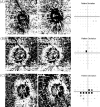Ocular and Hemodynamic Factors Contributing to the Central Visual Function in Glaucoma Patients With Myopia
- PMID: 35604665
- PMCID: PMC9150826
- DOI: 10.1167/iovs.63.5.26
Ocular and Hemodynamic Factors Contributing to the Central Visual Function in Glaucoma Patients With Myopia
Abstract
Purpose: The purpose of this study was to investigate the ocular and hemodynamic factors contributing to the central visual function in glaucoma patients with myopia.
Methods: This study was a prospective observational study, which included 236 eyes of 140 patients with normal-tension glaucoma (NTG), which includes 114 eyes with mild myopia (axial length ≥24 and <26 mm) and 122 eyes with moderate-to-severe myopia (axial length ≥26 mm). Ocular characteristics were axial length and posterior pole profiles, including peripapillary atrophy (PPA) to disc area ratio, disc tilt ratio, disc torsion, and disc-foveal angle. Hemodynamic factors included standard deviation of the mean of qualified normal-to-normal intervals (SDNN) of a heart rate variability (HRV) test and vessel density (VD) parameters from optical coherence tomography angiography (OCTA). The root mean square error was estimated as a measure of the VD fluctuation. Association between ocular characteristics and VD parameters of the OCTA with the central sensitivity of the 10-degree visual field or the presence of central scotoma were analyzed.
Results: Deep layer VD of the peripapillary and macular areas showed significant differences between mild and moderate-to-severe myopia (P = 0.034 and P = 0.045, respectively). Structural parameters, especially PPA to disc area ratio, had significant correlation with peripapillary VD parameters in myopic eyes. Lower SDNN value (ß = 0.924, P = 0.011), lower deep VD of the macular area (ß = 0.845, P = 0.001), and greater fluctuation of deep VD in the peripapillary area (ß = 1.517, P = 0.005) were associated with the presence of central scotoma in patients with glaucoma with myopia in multivariate logistic regression analysis.
Conclusions: The structural changes by myopia, especially in the peripapillary region, affected VD parameters in myopic eyes. Lower deep VD and greater VD fluctuation in the peripapillary region showed association with central scotoma in patients with glaucoma with myopia, suggesting both structural and vascular changes by myopia may be related to central visual function in glaucoma patients with myopia.
Conflict of interest statement
Disclosure:
Figures


References
-
- How AC, Tan GS, Chan Y-H, et al. .. Population prevalence of tilted and torted optic discs among an adult Chinese population in Singapore: the Tanjong Pagar Study. Arch Ophthalmol. 2009; 127: 894–899. - PubMed
-
- Vongphanit J, Mitchell P, Wang JJ.. Population prevalence of tilted optic disks and the relationship of this sign to refractive error. Am J Ophthalmol. 2002; 133: 679–685. - PubMed
-
- Choi JA, Park H-YL, Park CK.. Difference in the posterior pole profiles associated with the initial location of visual field defect in early-stage normal tension glaucoma. Acta Ophthalmologica. 2015; 93: e94–e99. - PubMed
-
- Scott R, Grosvenor T.. Structural model for emmetropic and myopic eyes. Ophthalmic Physiolog Optics. 1993; 13: 41–47. - PubMed
Publication types
MeSH terms
LinkOut - more resources
Full Text Sources
Medical

